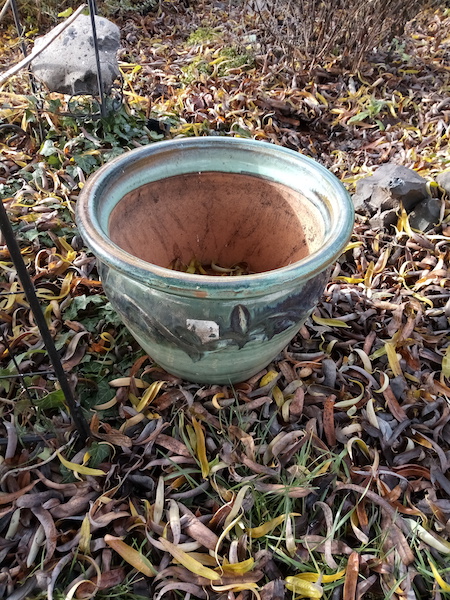Why Paint the Pot?
“I’m not really talking about painting at all, I’m talking about sketching. I don’t even own any paint except for a couple of cans stored in the garage and last opened five years ago to cover the walls in my bedroom. But I find myself thinking like a painter; I am seeing and feeling the scene as if I were J.M.W. Turner or Edward Lear stalking out new territory, even though there’s neither brush nor canvas in sight, only my little black zipper-bag selection of drawing pencils and my brand new acid-free sketchbook.”—Anita Sullivan
On the Other Hand
By Anita Sullivan

EUGENE Oregon—(Weekly Hubris)—January 2020—When I tell myself I want to paint an empty plant pot in my garden, I’m not talking about applying paint to the pot itself. The pot has already been “painted” but not PAINTED, if you take my meaning. The entire pot, inside and out, is exposed to view now that it has been emptied of soil and flowers in expectation of five long months of rain, winds, and darkness. Its original orange clay exterior was long ago covered over with a glaze of pale aqua with a dark green abstract (or more likely “haphazard”) design caught in a loose unravel around the top. The pot is quite lovely. I would like to paint it.
Here comes the catch—I’m not really talking about painting at all, I’m talking about sketching. I don’t even own any paint except for a couple of cans stored in the garage and last opened five years ago to cover the walls in my bedroom. But I find myself thinking like a painter; I am seeing and feeling the scene as if I were J.M.W. Turner or Edward Lear stalking out new territory, even though there’s neither brush nor canvas in sight, only my little black zipper-bag selection of drawing pencils and my brand new acid-free sketchbook. Hence, the title of this essay ought to be “Why Sketch the Pot?” But it is not.
Why NOT paint the pot? Because the inevitable result will be another mediocre still-life. Because the pot is not beautiful enough to deserve painting by anybody. [Beautiful enough?] Because duplication just leads to dilution, to dumbing down—what can the likes of me possibly add? So, there must be another reason for my irrational wish to paint this pot, despite strong evidence that it would not be worth the effort.
I sit on the bench squinting at the pot, making calculations about the best angle: how much of the inside should I include? How many distinct shapes are we talking about? How many shades of gray- green will do justice to the country someone idly splashed across the rim? Already I notice trees gently swaying, a pathway through a distant gate, the blur and hunch of a desert landscape on the other side . . .
I want to paint this pot because there is a small chance I may find a soul coiled up at the very bottom disguised as a yellow leaf. The evidence mounts. Around the pot’s base now in early December the soft brown and yellow willow leaves are revealing themselves to be a crowd of supplicants outside a city wall. Here a slender woman turns her back to me, slightly bent over a bundle protruding from her lap; a face with a huge bulb of a nose rests alone helplessly looking upward; gamin-faced children peek slyly from under yellow flags; nameless small animals with sinewy legs scramble, splay and flutter in all directions. As if, eons ago, a Great Pot had descended from the heavens and landed at the edge of a quiet village, throwing its inhabitants into a high state of turmoil. That turmoil has now slowed almost to a halt. To a still life. Waiting, in its present state, to be fully acknowledged.
![]()
To order Anita Sullivan’s books, The Rhythm Of It and/or And if the Dead Do Dream, click on the book covers below.




One Comment
Diana
Ode to a Grecian Urn? Only you could spin poetry from an ‘unpainted’ pot. Bravo, koritsi mou.